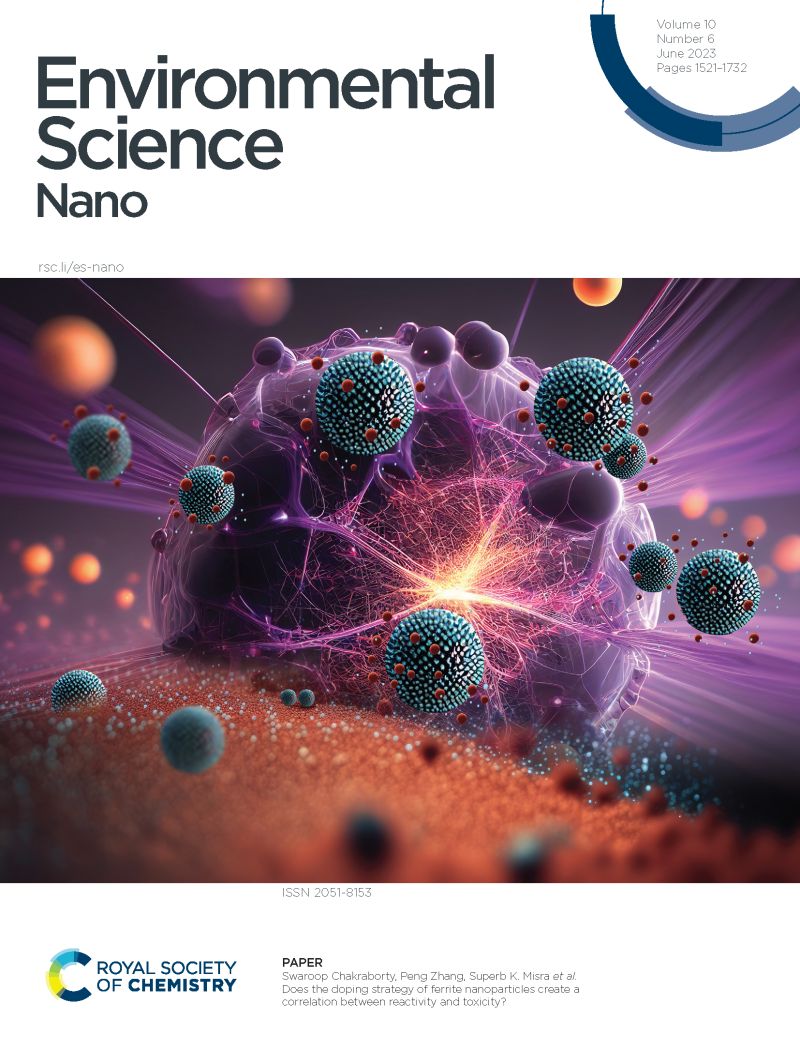Enhanced mineral carbonation on surface functionalized MgO as a Proxy for mine tailings
IF 5.8
2区 环境科学与生态学
Q1 CHEMISTRY, MULTIDISCIPLINARY
引用次数: 0
Abstract
The escalating demands of industrialization and development underscore the necessity for an efficient and scalable Carbon Capture and Storage (CCS) methodology. Mineral carbonation of MgO presents itself as a promising solution due to its considerable theoretical capacity for CO2 adsorption. However, the sluggish kinetics of the carbonation process pose a significant challenge. Consequently, a comprehensive understanding of the structural and chemical alterations occurring during carbonation is imperative for material design. In this study, we conduct a thorough structural and chemical investigation of the MgO (sourced from different mine tailings) carbonation process using electron microscopic techniques. Our findings demonstrate that treating MgO with polar solvents enhances its degree of carbonation significantly, offering a promising avenue for improvement. Moreover, we observe a particle size dependency in MgO carbonation and note that the inclusion of additional materials, such as Si-based compounds, further accelerates the carbonation. Density functional theory (DFT) calculations provide insight into surface functionalization as a result of solvent treatment and its mechanistic effect on the origin of the enhanced carbonation of polar solvent-treated MgO, revealing a stronger interaction between CO2 and the treated MgO (100) surface as compared to the non-polar solvent treated surfaces. These discoveries showcase an alternative approach for enhancing MgO carbonation, thereby offering a potential method for sequestering atmospheric CO2 more effectively using mine waste rich in MgO.不断升级的工业化和发展需求突出表明,需要一种高效、可扩展的碳捕集与封存(CCS)方法。由于氧化镁具有相当大的二氧化碳理论吸附能力,因此矿物碳化是一种很有前景的解决方案。然而,碳化过程的缓慢动力学是一个重大挑战。因此,全面了解碳化过程中发生的结构和化学变化对于材料设计至关重要。在本研究中,我们利用电子显微镜技术对氧化镁(来自不同的矿山尾矿)的碳化过程进行了全面的结构和化学研究。我们的研究结果表明,用极性溶剂处理氧化镁可显著提高其碳化程度,为改进材料提供了一条可行的途径。此外,我们还观察到氧化镁碳化过程中的粒度依赖性,并注意到加入额外材料(如硅基化合物)会进一步加速碳化过程。密度泛函理论(DFT)计算深入揭示了溶剂处理导致的表面官能化及其对极性溶剂处理过的氧化镁碳化增强的机理影响,揭示了与非极性溶剂处理过的表面相比,二氧化碳与处理过的氧化镁(100)表面之间更强的相互作用。这些发现展示了增强氧化镁碳化的另一种方法,从而为利用富含氧化镁的矿山废料更有效地封存大气中的二氧化碳提供了一种潜在的方法。
本文章由计算机程序翻译,如有差异,请以英文原文为准。
求助全文
约1分钟内获得全文
求助全文
来源期刊

Environmental Science: Nano
CHEMISTRY, MULTIDISCIPLINARY-ENVIRONMENTAL SCIENCES
CiteScore
12.20
自引率
5.50%
发文量
290
审稿时长
2.1 months
期刊介绍:
Environmental Science: Nano serves as a comprehensive and high-impact peer-reviewed source of information on the design and demonstration of engineered nanomaterials for environment-based applications. It also covers the interactions between engineered, natural, and incidental nanomaterials with biological and environmental systems. This scope includes, but is not limited to, the following topic areas:
Novel nanomaterial-based applications for water, air, soil, food, and energy sustainability
Nanomaterial interactions with biological systems and nanotoxicology
Environmental fate, reactivity, and transformations of nanoscale materials
Nanoscale processes in the environment
Sustainable nanotechnology including rational nanomaterial design, life cycle assessment, risk/benefit analysis
 求助内容:
求助内容: 应助结果提醒方式:
应助结果提醒方式:


